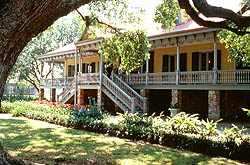|  Laura Plantation house Laura Plantation house
Courtesy of Lagniappe Tours, Foundation for Historical Louisiana Two slave quarters at Laura Plantation Two slave quarters at Laura Plantation
Courtesy of Lagniappe Tours, Foundation for Historical Louisiana |
Situated
on River Road between Baton Rouge and New Orleans, the Laura Plantation
complex is located just upriver from the west bank community of
Vacherie. The plantation is significant for its raised Creole plantation
"big house" and its rare collection of outbuildings, including six
slave quarters, that illustrate the development of a sugar cane
plantation from the antebellum period well into the 20th century. The
land on which Laura plantation stands was originally owned by André
Neau, who obtained it through a French royal land grant in 1755. In the
late 1700's, the plantation became the property of the Dupare family and
was divided between two family members in 1876. The house continued in
the hands of Dupare heirs until 1891, when Dupare descendant Laura
Locoul sold the property to A. Florian Waguespack. A condition of the
sale was that the plantation and house continue to be called "Laura".
Constructed c.1820, the main house at Laura has a raised brick basement
story and a briquette-entre-poteaux (brick between posts) upper floor.
The house is special because of its Federal style interior woodwork and
Norman roof truss. In Louisiana, far more Creole houses with Greek
Revival woodwork have survived than have those showing Federal
influence. Few examples of the Norman roof truss construction technique
survive, and they are usually found in very early Creole houses.Although
Creole residences once dominated the rural landscape of central and
southern Louisiana, today perhaps only 300 to 400 examples of these
buildings remain standing outside New Orleans. Of these, the majority
are small or moderately sized one-story houses, while only approximately
30, including the main house Laura, are members of the distinct group
of substantial raised plantation houses regarded as the apex of the
Creole style. Little attention has been given to preserving the coterie
of dependencies that were the "workhorses" of cotton and sugar
production on Louisiana plantations. Historically the state was dotted
with hundreds of plantation complexes such as Laura, but today they are
rare survivors. One of about 15 surviving plantation complexes in the
state, Laura might be compared to
Whitney or
Evergreen plantations
in St. John the Baptist Parish. Thus, it is a very important visual
reminder of the large agricultural enterprise common in antebellum and
post-war Louisiana.
Laura Plantation is located on River Road
midway between Baton Rouge and New Orleans. The home is open for tours
daily, except for Creole holidays (New Year's, Mardi Gras, Easter,
Thanksgiving, and Christmas). The first tour is at 10:00am, the last at
4:00pm. Gates close at 5:00pm. There is a fee for admission and groups
are encouraged to call ahead. Call 225-265-7690 or visit the website for more information.
Source: Internet
 Laura Plantation house
Laura Plantation house Two slave quarters at Laura Plantation
Two slave quarters at Laura Plantation 

